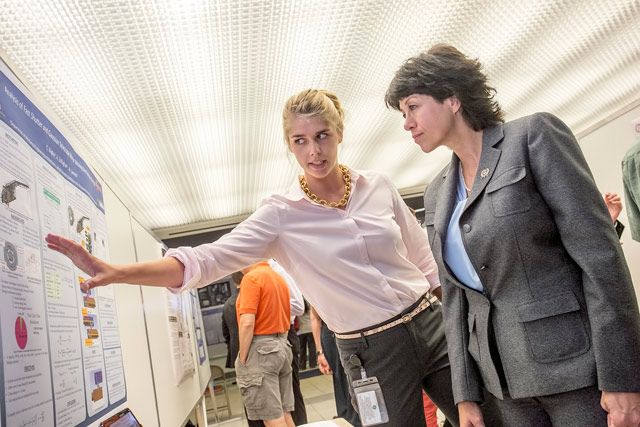Last Fall, Cara Bagley ’16 found herself at a Girl Scout event focused on science, technology, engineering, and math, encouraging an audience of young girls who may one day pursue interests and opportunities in these fields.
It’s funny how things work – she ended up on the receiving end of some encouragement of her own.
During the workshop, she struck up a conversation with Ray Camp, an engineer at Princeton University’s Plasma Physics Laboratory (PPPL). Camp invited her to apply for the 10-week Science Undergraduate Laboratory Internship (SULI) program at PPPL. After Camp later gave her a tour of PPPL, Cara become immediately interested in the internship program.
Sponsored by the U.S. Department of Energy, SULI is an intense, highly-selective 10-week summer research immersion in one of the country’s premier labs, PPPL. Cara was one of only 25 students accepted into this prestigious program, which itself is set up specifically to encourage students to pursue STEM careers.
“I learned so much,” Cara says. “I learned to teach myself, how to effectively use my resources, and how to apply knowledge I had learned, some I’d forgotten, and even some I’d not previously learned.”
The internship began with a one-week course in plasma physics. It’s a good thing, too -- Cara was not previously familiar with, or by her own admission even interested in, plasma physics prior to the PPPL experience.
After the course, interns were paired with a mentor and worked on a research project together. The projects sought to analyze mechanisms to be used within fusion reactors, specifically ITER. ITER is “a large scale scientific experiment intended to prove the viability of fusion as an energy source,” according to ITER’s website.
Cara was paired with Ali Zolfaghari, a Lead Research Engineer for PPPL.
“Zolfaghari is a great physicist who let me work independently,” Cara recalls, “ but he was there with all the answers I needed when I needed it,” Bagley said.
Cara’s main project involved working on a mechanism called “The Self-Aligning Mirror Mechanism for Transmission Line Offset Correction.” Design engineers at PPPL had already designed a mechanism to maintain the incidence of a wave when the wave source is moving relative to the target. It was then Bagley’s responsibility to use the program ANSYS Rigid Dynamics to analyze the movement of this mechanism. The mechanism will hopefully be used within the fusion reactor.
The program ended with a peer-reviewed poster presentation. Donna Simon, a congresswoman from her district in New Jersey, came to Cara’s presentation and presented her with an award for participating in the program.
Cara says that her experience working with students from across the country was incredibly interesting. Each of her peers in the program came from a different background, and provided one another with new perspectives.
“It was a really rewarding experience overall,” she concludes. “I’m really glad I did it.”
-Sarah Plombon '16 is a journalism student interning with the P.C. Rossin College of Engineering and Applied Science.

